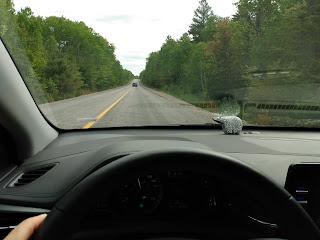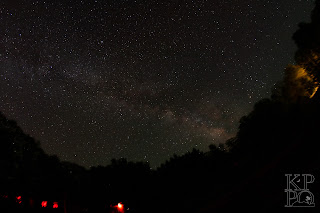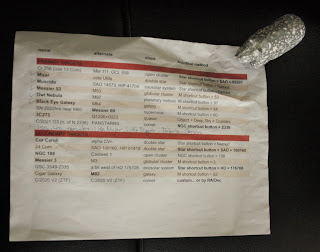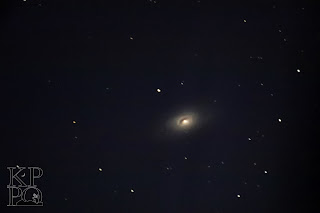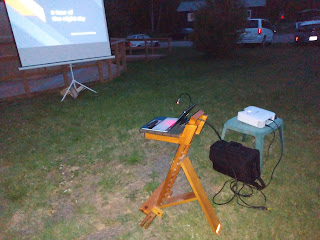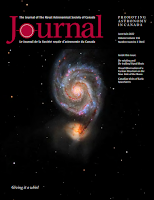8:07 PM, Tuesday 17 May 2022. Well, hello. Checked the voice recorder: 7 hours left, good.
KPPO Kchi observatory open, UPS on, caps off, dew shield on, power bar on. Dual camera rig back in the 16; 21mm eyepiece back in the 130. Normal config.
Oregon Scientific weather station out in the open... Humidity was low (for now).
Brought my DSLR out for another ISS run, already on the tripod. Wrong lens. Also brought out my dew fighting case...
Some blackflies were around. Put some DEET cream on. Found my hat.
Connected power for the KPPO Dell computer. Confirmed connection. Windows wanted to do an update so I applied it. I deferred the Windows 11 update. That'll be a kick in the head.
Put the power supply for John Grim aside. Wondered where I'd put everything, need more desks, for all the computers. Left computer closed for the moment.
Reviewed the plan:
- get the big 'scope running; put it on something, a star, say Arcturus in the still bright sky; align and sync the big 'scope
- image the flyover around 10 o'clock
- image the supernova before the Moon rose, about an hour window
- then do some general stuff, my personal things...
Headed outside to do preliminaries for the wide-field shooting. Put the Rokinon 8mm lens on. Attached the DC coupler to the observatory power source. Aimed roughly, considering the path starting from WSW. Test shots. Brighter sky so dropped the ISO. Attached the intervalometer and it showed the problem again, working intermittently. A bit of pressure on it seemed to make for a good connection so I put some tension on the cable and secured it. Test again - seemed flawless.
Decided to hook up the dew heating. Used my custom warmer strap on the lens, secured with a large twist-tie, my do-it-yourself controller None More Black, powered from my hacked computer power supply unit. Power it all up and turned it (almost to 11) to see if all was working...
The 40D was ready to go.
8:28 PM. Back in the observatory.
I thought about the Stellarium training happening right now. Kersti was teaching while I was sorta working. Neat. Saw an email for one participant, with a time-stamp shortly after 7. Hope they got in.
Wanted to check my notes. In Evernote, so I needed a computer. Tried the observatory small chair, a little low. But it let me have both computers side by each.
Confirmed with Unify to access the internet. Medium signal. (I was letting the Dell have the hard line.)
Asked Google to set an alarm for 9:45. Took 2 attempts, silly global computer.
The flyover started at 9:54, would be visible around 9:57. So basically a 10 PM pass.
I was thinking I'd image with the 16, the supernova. Connected the USB hub data cable to the Dell (with an adapter) to the last available port.
Flipped Chrome to dark mode. Checked the weather pages. Clear skies. Wow. It had opened up right over top of us, though there was something over Superior and moving east quick. I hoped it would dissipate. Pretty well gone? The lakes were still cold, Erie the warmest, Superior the nippiest. CSC. Updated EC for the town of Killarney: tonight, clear, wind north 20, becoming light early this evening, low zero with patchy frost, tomorrow, sunny, high 11, UV index 7 or high, night-time partly cloud, becoming cloudy after midnight with showers, wind becoming south-east 20 before morning, low 7. Gonna get cold tonight, with frost... (i.e. dew). Good for tomorrow for solar viewing.
Astrospheric showed good conditions. It showed three ISS flyovers. Oh ho. I never did this before. When you click the icon a page appear with the overhead sky and path drawn, plus times. Funny order I thought; I'd make it Rise, Max Alt, Set. There's a Remind feature--with a Pro account. Confirmed the 10 PM one was the best (or brightest).
My sister texted me. She shared that the Merlin app (from Cornell) on a phone can identify birds by song. I'm not that hard-core.
Decided to get APT ready.
Sheesh. The site coordinates prompt again. A location has not been set. So I would do them a favour. Entered the name, lat, long, elevation, time zone. Looked like it worked. I examined the Darkness Bar.
Heh. Latitude 46. I'm 4 more north than normal...
There was also a pop-up about a new version, 4.0. They are running APT version 3.90.
APT takes PHD input. Robust. Many features than Backyard, I think. Can control the mount, the focuser, a rotator, with additional Tools, INDI and INDIGO. Found the past images preview.
Entered SN 2022hrs for the target name in APT.
Considered taking darks and flats. Except I didn't know where the power cord was for the light panel.
8:55. Went to check the dew heater on the 8mm lens. It was warm. Local conditions: 52%, 8.5°, pressure dropping, clouds tomorrow. Examined the focus.
Would not reach astro twilight until 11. Son of a gun. Then the rotten Moon would come up. The sky would be bright while I was trying to get to the galaxy. Looking ahead, Virgo objects would get good.
9:00. Quickly cleared the phone alarm. Checked the email for a Stellarium report. Nothing yet. But they'd be wrapping...
Decided to go for Arcturus. The GPS Fix occurred in the usual three asterisks. But nothing in the eyepieces. Nada. Fired up Stellarium. Software suggested it was visible to the eye.
9:05. I surmised the mount was way off. Reboot! Arcturus again. I looked again the finder and many 'scope OTAs. I panned and hunted for a bit. Nyet. Left it for a bit.
Pined for binoculars.
Put on my specs and looking around, with corrected vision.
It occurred to me that the long stalk on the finder scope needs to be turned. It'll poke your eye out! Should be near the body of the 16-inch.
Thought I had it but then lost sight of the star in the east... Or was it my imagination?
Sis texted me again. Asked if I got to see the eclipse.
Spotted Arcturus, higher up. The mount was way off! Way too low. Fiddling with my specs, I got it in the finder. Checked the frac. Weird, not co-axial again. Slewed to Messier 60. Wait, I decided to use a nearby star, Vindemiatrix, for syncing. The AutoStar hand controller is not very "smart." It dropped me into the named star list in the E section. Why? And I believe it shows every named star in its catalogue, even ones below the horizon (which might be dangerous). Two line menus! Grrr.
Nevertheless, synced. And the settled on M60.
I wondered if the various panels could be closed or minimised in APT. They are distracting.
Did test shots. Blown out. Tried again.
It occurred to me I did not know if I was in focus. Back to Vind. Test shot. Why did the ISO change. Oh. There was a star. Centred. Course, fine, and electronic focus. Too bad there are no readouts for focus. Back to M60. ISO changed again. Bonkers. Lost my settings. ISO 800. Too much. 400. Blue sky.
9:28. Spotted Kersti's report. I thanked her. And confirmed that the Stellarium Absolute and Relative star values do not correspond to the Bortle scale.
Put the red film on John Grim. Connected the red keyboard light. Set the app to red mode.
Tried another test shot.
Ah. Saw a fuzzy blob. Yeh.
Noted a weird pattern, vertical light and dark regions, in the 'scope or on the Dell screen?
Went back to ISO 800. Galaxy. And some stars. Compared to SkyTools Visual. ISO 1600. Right, the mirror diagonal was out so even reflections, not the usual three reflections. 10 seconds, ISO 1600. I confirmed when you go back and forth between Live View and Shoot, it throws away your settings. Annoying.
Went outside and checked the intervalometer function.
Couple of dudes came through. He recounted a U of T astronomer from last year. Not me.
Turned on the red flashlight for light painting.
They spotted it first. Dim. Got brighter. Then brighter than any star. Good pass. When past the range of my fisheye, I stopped the intervalometer. Checked the spherical lens. Clear! Sweet. (Either it was not humid or the dew heater worked.)
We talked about internet satellite services.
Offered a view of the main 'scope imaging. Panned a bit to centre. M60 and NGC 4647. Hey, spotted another galaxy, 4638. Cool.
Liam and Philip headed out. Invited them out tomorrow.
10:16. I wanted to set up a plan in APT but couldn't figure it out. Did it manually. Pausing 5 seconds. A meat puppet.
The program shows in the Status column the letter E for the exposure duration. And it counts up. It should count down. I watched the real-time clock at the top-right to do an in-my-head gap or delay. I could not see camera data per the sensor temperature.
First, it would let me do anything until I selected the frames type. I chose Light. But then it wouldn't let me set the gap or the reps. Not obvious how it works. I suppose I could have read the manual in daylight.
10 seconds, ISO 12800. Verified it was working, noting the last image shift.
Checked the roof clearances.
There was a double star at the bottom-left of the field. SkyTools did not show it. In fact, it didn't show any star there at all.
[ed: NGC 4638 is very bright like an elliptical but also looks like an edge-on spiral. ST4 says it is a lenticular galaxy. Uh huh. aka MCG 2-32-187, UGC 7880, and PGC 42728. This is south-west of M60. Immediate left or west of 4638, in the processed image, is a faint but mottled shape, about the same size as 4638. This is, according to the software, NGC 4637 or MCG 2-32-188, UGC 7881, PGC 42744. It too is a lenticular. Dim! South-south-east of M60 is another faint fuzzy. It's quite small. The SkyTools Object Information says it is LEDA 1394064; the chart label though it Z 71-18.]
Felt cooler. Temp dropping. Planned a run to get another sweater and the coat.
Dove into Windows File Exploder to see how many images I had so far. 103. And that was RAW and JPEG. So 50. Decided to do another 10.
A couple more...
OK. Lots of images of a supernova and a few galaxies in Virgo, in dark skies!
Nothing visible in the Live View. So the DSLR is no good for live views of faint galaxies.
Left the observatory to put on more layers.
(And I totally forgot to shoot darks!)
When I returned... I needed some Whole Sky. I laid down on the deck, eyeglasses on, so to enjoy the very dark sharp skies of Killarney. Stunning.
10:46. Issued a Disconnect. Closed APT. Shut the camera off. Shut down the Dell and closed it. The Dell power USB-C plug had a white LED on both sides. Ugh. I covered it.
Moved my laptop atop.
Oh! I could go for a Deep Sky Gem!
Reset the filter for the "personal projects" list. 187. Reapplied the time limits. Best quality. Down to 90. A target in Boötes, not far from Alkaid. With such a high target, I'd need to move the roof. All right.
Then I slewed to Mizar. Nearly straight up. Crawled under the rig to look through the finder scope. Panned about, on my way. When the mount suddenly "skipped." What?! That was upsetting. The balance of this thing is so precarious.
I thought about quitting.
Let's try again. I parked it. Booted it up. Went to Arcturus. Synced.
Selected Mizar. It was actually closer from the get-go. Synced. Where the heck were we. Let's resume.
11:12. Mizar A and B with Alcor and the star in the middle. It looked pretty good in the 130 refractor (as it should). 21mm eyepiece, wide field. 43x.
OK. Off to Alkaid. Field hopped in the frac comparing to the SkyTools charts. Bumped the slew speed. Doubles, Big Ls, something zipping through followed by a satellite, wide stars, many bright stars. Arrived Alkaid.
The quarry was next. To the east.
11:20. The Moon was up. The sky was brightening. That magnificent sky was going away. A few days later, I'd do a NELM test on the Little Dipper. I suspect this is darker than Mew.
Faint stars. Less. Damn it. I accidently dragged in the Atlas and lots my markers. Fire truck! Reselected the target in the list. Resumed the hop. OK, another waypoint. Quadrangles. Spotted 24 Boötis. Then HD 127824 and to the right of that faint TYC 03476-0117 1. Further to the right, south-east, my fuzzy galaxy NGC 5676. Got it!
I saw it in the refractor.
11:30. Needle shape. Tuned the angle in the software. The galaxy was angled north-east to south-west. Centred it.
Removed the power and data cables from the imaging rig and inserted my diagonal and my baader zoom, set to 24mm. Took some force to get the cap off. Worried I was gonna screw up the hair-trigger mount.
There it was.
It was hard to focus manually with the 'scope shaking.
Definitely saw it.
Centred at a slow rate.
Fine tuned the focus with the hand box.
Bright core, with averted. Tiny bright core. L-shape of stars around it. Pretty sure it was a spiral, canted. The sky was starting to wash out. Seemed fairly uniform in its shape.
The sky was grey.
Checked the view in the software. I had the zoom in the software, ready to go. North was at the 2 o'clock position. The 24 didn't seem to closely match; the 20 looked better. It was in an L-shape with stars TYC 03476-0169 1, TYC 03476-0021 1, and GSC 03476-0122 (a mag 13.5 star).
Marked as observed!
Woo hoo.
11:46. Considered a double star since the sky was getting bright. The Moon was still behind the trees. Earlier, I had bookmarked Virgo in Haas's book but I flipped to Boo, since I was already there. And I started at the end of the list. Two pairs.
Selected Otto Struve 298. aka HD 139341 or SAO 64800. The HIP matched. I slewed.
I noted a wide double in the finder. At first, it didn't seem right in the refractor. Definitely on the right one. Turned off the ACO display.
11:55. I was confused. In the refractor, I only saw two stars. SkyTools showed a third. I didn't see it. Couldn't get the software to mimic the view.
OK. The obvious stars were A and C. Check.
SkyTools showed a "D star" but it was the core of a galaxy!
I also spotted the E star, faint, in line, 3 to 4 times the distance. Haas doesn't note it.
Oh dear, A and B were 0.8 seconds of arc apart. Maybe not. Fast binary.
Noted the gaggle of stars above, some 5 or more stars, a different system, given another C companion. SkyTools identified as a KZA double. Added it. Saw some of it.
Had another swig of water from my glow-in-the-dark water bottle.
The seeing was bad in the big OTA.
Oh ho. I saw the galaxy! NGC 5966. Wild.
Whoa. I got it. A and B, despite the collimation issue. Same colour, same brightness. Oriented 3 and 9. Aimed toward the faint star (GSC 03053-1207, a mag 14.9 star) near the galaxy. Neat!
12:04 AM. Wednesday 18 May 2022. Wow. Didn't expect to get a sub-arc-second split here. Impressive. Confirmed the angles. Below was the bonkers system, the wide faint stars.
{ed: Hold up. Didn't notice at the time that the SkyTools 4 Visual Object Information box had this to say about OΣ 298. The PA is 192° and the Sep 1.17" (as of 2022.4). Checked Stelle Doppie. It too reported the AB stars at a separation of 1.2".}
One more.
Yep, stars A, B, C, D, E, F, G, H, and I. Oval shape. More like a little asterism or open cluster. I'll take it!
OK. That's enough. Put my eyeglasses away. Threw the dew fighting case inside the dome. Closed up shop.
12:21. Moon was coming through the trees. The Oregon was fogged. 1.8 degrees, 68 percent.
Locked up.
Hauled the carrying case and camera-plus-tripod inside.
1.4, 69, gonna rain. Brrr.
